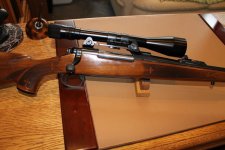I agree that following the rules of safe gun handling would have prevented all of the injuries/deaths attributed to 700 triggers.
-
Always keep the gun pointed in a safe direction.
-
Always keep your finger off the trigger until you're ready to shoot.
-
Always keep the gun unloaded, until you're ready to use it.
I've been shooting Remington 700's for over thirty years and currently have nine of them and a 40X, so I have a fair amount of experience with their old triggers (not the X-Mark). I've adjusted dozens of them (for myself and others), but I follow Remington specifications that were published before the lawyers put a stop to it. I had a problem with the trigger on one of the guns that was purchased used, but a good cleaning and proper adjustment cured it.
The recall is for pre-1982 guns and the modification allows unloading the rifle with the safety engaged. The original safety on these earlier guns locks the bolt, which is a feature I actually like. I once lost a cartridge while I was working my way up a mountain with a later model 700 slung over my shoulder. I may have brushed it against some scrub oak, but I discovered the bolt all the way open and the chambered cartridge long gone when I got to the stand. $3 down the tubes! I also witnessed someone miss their first attempt on an antelope, when their gun failed to fire. The bolt handle got nudged up a tad when the safety was on and he didn't notice it. When he pulled the trigger, the striker force was bled off enough closing the bolt that the cartridge didn't fire. There was a very light dent on the primer. He did get the goat after racking in another shell.
It's important to keep the trigger group clean and a lot of owners don't give it a second thought. Some of these guns are over 50 years old and gradue can accumulate and cause malfunctions. I don't disassemble the triggers, I simply pull the action out of the stock, spray the trigger group with action cleaner and give it a light lube.
The original 700 triggers are actually quite good when properly adjusted, but it's important to not set them below 3-1/2 lbs. I don't know how heavy the factory sets the pull because my TP scale only goes up to 72 oz, but I do know that I need to bury the needle and reef on it some more to release the striker on most of the guns I've examined. Remington puts a goober of epoxy over the adjustment screws to keep them from moving, but it's easily removed with a razor blade. After I make adjustments, I clean the area with alcohol and re-apply jewlers epoxy.
Here's the old factory instructions for adjusting triggers:
Since we're talking 700's, I've included a gratuitous photo of one I just picked up at a swap meet on Mothers day.

It's a 1965 BDL with the factory stainless steel barrel chambered in .264 Win Mag and topped with a Bausch & Lomb Balvar 8A. It's definitely not going back for the recall modification!



